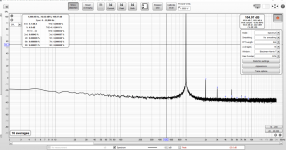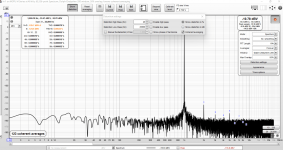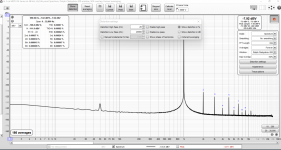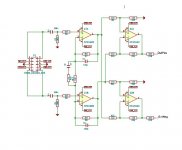I don't think it looks so bad. Harmonics below -120 dB.
You should really change the Y-axis unit (from SPL to dBV) and tell RTA what the input level is (in the top box labeled "FS sine RMS") if you want sensible numbers for noise.
You should really change the Y-axis unit (from SPL to dBV) and tell RTA what the input level is (in the top box labeled "FS sine RMS") if you want sensible numbers for noise.
Now we're getting somewhere. 000079% THD / 0002% THD+N ! I find the motu is easily over driven. You may get even better THD figures around -30 dBFS
Has anyone identified these distortions as thermal distortion? It should look striking, as it must be a H2 harmonic with -90° phase. For a standard 0.6 W axial wire resistor with a Tc of 50ppm this H2 calculates to -130 dB if 1 kHz sin max power applied. If 10% power applied it should be -150 dB.
Noise related numbers are not valid when using coherent averaging. That is why they are displayed in orange.Now we're getting somewhere. 000079% THD / 0002% THD+N ! I find the motu is easily over driven. You may get even better THD figures around -30 dBFS
Calculate or us a web converter like this.
How did you determine that the FS sine Vrms is 2.75V?
I used my dso scope with rms readings but used a 1x bnc to phono wire first with the scope set to 10x so ignore that reading.
Here ive used the correct 10x probe to measure 1vrms from the oscillator then connected it all back up, this is what I have now,
Attachments
From memory it was only about 150mV RMS before the THD started to creep up. I guess the easiest thing is just reduce the level to optimum THD reading. Also saw somewhere the Vic Osc. has a minimum output of 300mV ?
The link in #1177 indicates it may be important to keep Victor's oscillator output set to max, and attenuate externally if noise level becomes a concern.
please can you please switch on phase information for the distortion display, i want to compair that to my motu.I used my dso scope with rms readings but used a 1x bnc to phono wire first with the scope set to 10x so ignore that reading.
Here ive used the correct 10x probe to measure 1vrms from the oscillator then connected it all back up, this is what I have now,
Before I make and post anymore readings I want to make sure my cables are 100% wired correctly, so please correct if any errors
Input from Victors Oscillator Phono to XLR connected at XLR end signal to pin 2 ground to pin 3
Input from Victors Oscillator Phono to STEREO TRS connect signal to Tip and ground to R
Measured signal from dummy load to AutoRanger MONO TRS signal to Tip and ground to Sleeve
Input From Auto Ranger to Motu MONO TRS signal to Tip ground to Sleeve
Input from Victors Oscillator Phono to XLR connected at XLR end signal to pin 2 ground to pin 3
Input from Victors Oscillator Phono to STEREO TRS connect signal to Tip and ground to R
Measured signal from dummy load to AutoRanger MONO TRS signal to Tip and ground to Sleeve
Input From Auto Ranger to Motu MONO TRS signal to Tip ground to Sleeve
Have a look at Wtnh's diagram in post one. This utilizes the balanced input of the MOTU. I can't get rid of the last bits of mains noise (probably needs to be shielded, 0.1% resistors etc.) but gets readings down to ~120dB THD. Xrk how about a nice little active unbal to bal converter with input attenuation and output clamping to protect our sensitive sound cards!
I use this one. It converts any bal/unbal input to bal output.Have a look at Wtnh's diagram in post one. This utilizes the balanced input of the MOTU. I can't get rid of the last bits of mains noise (probably needs to be shielded, 0.1% resistors etc.) but gets readings down to ~120dB THD. Xrk how about a nice little active unbal to bal converter with input attenuation and output clamping to protect our sensitive sound cards!
Attachments
For the Motu, such a converter is really a good recommendation. Asymmetric signals show high THD. I use a similar converter to measure asymmetric signals.

Shielding is important, as well as a potentail free power supply, therefore i use a LiO battery pack to operate it. OPA 1656 may be better in terms of noise and THD, but i did not test that.
Shielding is important, as well as a potentail free power supply, therefore i use a LiO battery pack to operate it. OPA 1656 may be better in terms of noise and THD, but i did not test that.
Might give that a go. I wonder if running the 1656 @ +/- 2.5v would protect the soundcard input?
lower supply voltage increases distortion and affects other parameters. If your soundcard has proper input protection that should be sufficient.
- Home
- Design & Build
- Software Tools
- How to - Distortion Measurements with REW



